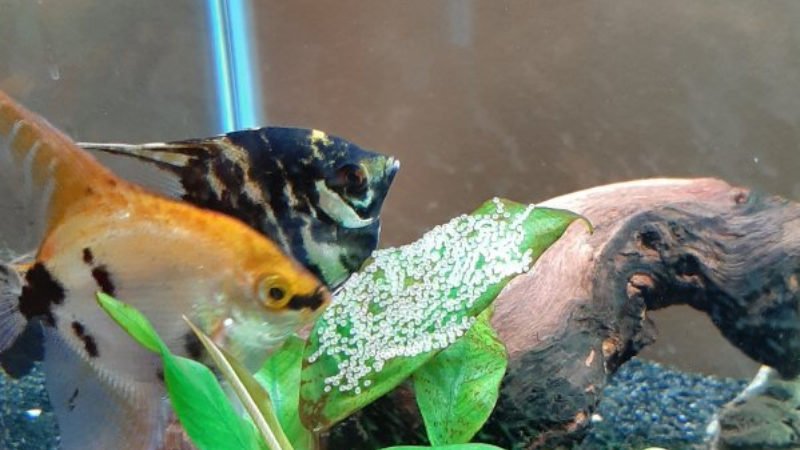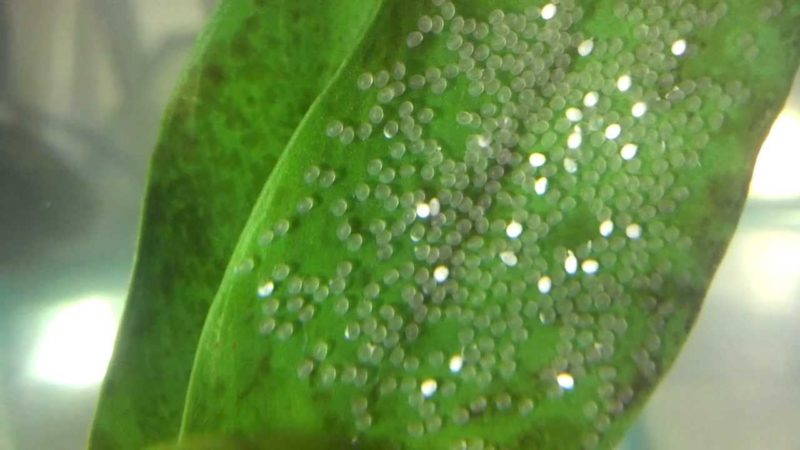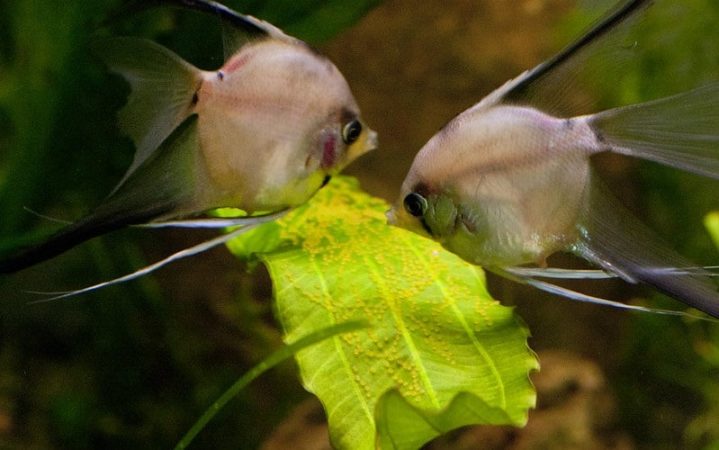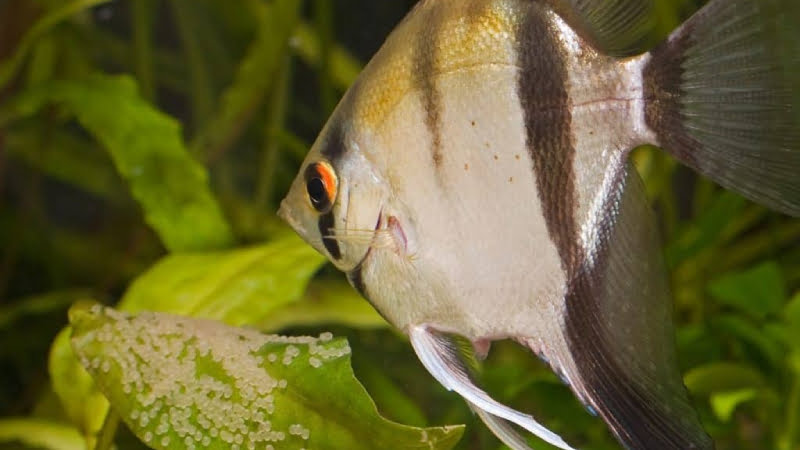Angelfish are among the most popular fish species for home aquariums. Numerous colours and sizes are available for this tropical fish, which makes angelfish extremely popular among aquarists. Angelfish can live for several years, and they reproduce rapidly as well.
If you are going to keep angelfish eggs, you will need to take into account various factors and provide the right conditions to allow them to reproduce successfully. Therefore, in this article, you will find a summary of all the important points and answers to some of the most common questions about angelfish eggs.
Related Articles:
- How To Tell If Angelfish Eggs Are Fertilized?
- Why Are Angelfish Eggs Turning White? 5 Best Ways To Avoid
- Angelfish Laying Eggs: 6 Important Things You Need To Know
- 10 Notes And Guide On Hatching Angelfish Eggs Artificially
- Will Angelfish Lay Eggs Without Male? How It Affect The Eggs
- Angelfish Eggs Fungus: How To Treat And Prevent Effectively
- Pregnant Angelfish Behavior: Clearest Signs That Indicate Spawning
Do Angelfish Lay Eggs?
To reproduce, fish can either bear live young or lay eggs, depending on the species. As expected, angelfish lay eggs as a means of reproducing. Eggs are laid by female angelfish, and then the eggs are fertilized by male angelfish.
In just one breeding cycle, female angelfish are able to lay between 100 and 1,000 eggs. Also, it is important to point out that a pair of angelfish can spawn every two weeks.
Spawning is simply the physical act of two angelfish mating. The angelfish don’t have a mate in the traditional sense, but in order to reproduce.
If you want to breed as many angelfish as possible, you should allow the angelfish to spawn and then remove the angelfish from their eggs to take care of them. The angelfish will once again be able to spawn after approximately two weeks.
Angelfish Eggs Stages
From the moment the eggs are laid until they hatch, angelfish undergo a brief but intricate breeding process. Here are some things you should know about this process.
Tidying The Breeding Area
Angelfish begin cleaning the aquarium tank in preparation for breeding. When mating angelfish are doing their job, they make sure that the spawning site is neat and tidy so that the female angelfish can lay the eggs.
They are very meticulous in this process, and it may take them a full day to complete. Nevertheless, it does not mean that the breeding area will not change in the future.
Are there any hotspots where angelfish lay eggs? It could be the heater, a tank wall, or even removable plants that prove to be hotspots where angelfish lay eggs.
Many aquarium owners place a designated breeding slate in the tank on which angelfish might lay eggs. The eggs can then be safely moved to a different tank before hatching.
Laying The Eggs
When the spawning area has been cleaned and organized, the female fish goes to work laying all her eggs vertically. After the female lays her eggs, the male follows suit quickly and will brush over the eggs to fertilize them. Angelfish eggs are translucent, smaller than a needle’s eye, and stick to the spawning area.

Between the laying and hatching stages is the crucial period, and this is when you can help as the caretaker. You must remember that angelfish will only breed under the right conditions. However, they are easily spooked, so it would be helpful to avoid any sudden movements or changes in the tank’s condition.
In some cases, people keep fertilized eggs in smaller tanks. After that, it is very important that you provide the perfect conditions for the hatchlings to hatch by performing a water change for 25% of the tank daily if you are able to do so.
In addition, continuous monitoring is essential, and unfertilized eggs have to be removed in order to protect the healthy ones.
Pre-Hatching Eggs
After the eggs have been laid for around 60 hours or so, the larva inside the eggs moves into one of its pre-hatching stages. As the larvae begin to develop, you will notice that they curl their bodies around the yolk sac.
Furthermore, you will notice that the eggs’ colour changes to a quite transparent colour. However, other developments, such as blood flow and heartbeat, are only visible under a microscope.
Wiggler Stage
As long as everything goes according to plan, you will be able to see the baby’s angelfish wriggling inside the eggs, which means fertilization was successful. During this stage, the babies attach themselves to the yolk of the egg and then eat the yolk in order to develop their vital organs.
The Fry Are Born
After 3-4 days, when the larval angelfish eat all their yolk sacks, they hatch and are called angelfish fry. Basically, all you need to do is provide them with microorganisms, which are usually found inside the tank, and keep a close eye on their growth.
What Do Angelfish Eggs Look Like?

Angelfish eggs are extremely small and resemble very tiny pearls, are just the size of a needle hole, not bigger than that. The eggs of angelfish should generally be transparent amber or brownish in colour. The presence of this colour indicates that the eggs are fertilized and healthy.
If you notice that your eggs are turning white and opaque, you should be worried. It doesn’t necessarily mean that they are dead, but their chances of hatching adequately are quite low unless the situation is rectified immediately. Therefore, you are strongly encouraged to pay attention to the eggs of your angelfish as soon as they are laid.
Pay attention to the colour. Make sure that the colour remains within the appropriate range. You will only be able to tell whether your eggs are healthy by this way.
How Long Does It Take For Angelfish Eggs To Hatch?
Angelfish are very fast at reproducing, and if you maintain the right temperature conditions, the eggs will hatch without any hassle. To make the process go as smoothly as possible, it would be best if the temperature was maintained at 80 degrees Fahrenheit.
On average, it takes around 60 hours for the eggs to develop, followed by a larval stage in which the larva remains attached to the yolk to obtain nourishment. After 3-5 days, the angelfish eggs hatch, and the larvae become free-swimming fry.
How To Prevent Angelfish From Eating The Eggs?
When breeding angelfish in a communal tank, aquarists must prevent other angelfish from eating the eggs. The fish often do this when they are stressed, and there have even been reports of pregnant fish eating their own eggs.

Some of the reasons for this might include the inexperience of the aquarists, the excessive commotion around the tank, and the unfavorable conditions in the water. Considering that your fish will need some space to relax, it would be a good idea to situate the aquarium in a quiet and comfortable part of your house.
As with humans, angelfish parents need to practice a bit before they may be able to raise their fry successfully. Therefore, if they do not give birth to fertilized eggs within a few attempts, it will be necessary for you to remain patient.
Furthermore, make sure that you clean your tank, maintain the ideal water temperature, and make the fish feel comfortable in the tank. In addition to this, you should feed them well so that their appetite is reduced so that they do not eat their own eggs.
How To Care For Angelfish Eggs?
Various types of angelfish exist, but the eggs of almost all of them can generally be raised very similarly. When the eggs have been laid on the slate, you can either remove them from the tank and raise them in a different location, or you can leave them in the tank for their parents to take care of.
Raising Eggs In A Separated Tank
You will want to have a special breeding tank where you can immediately remove the eggs once they are laid. This will help increase the chances of survival of the eggs since their parents are the first threat to them.
After that, you will have to ensure that the eggs are not damaged by fungus, debris, and other impurities. You will be the primary caretaker until the eggs hatch.
During the transfer of the eggs to the breeding tank, it is essential to keep the conditions the same. Therefore, it is necessary to keep the new tank ready one day before the transfer so that the conditions of the new tank are as similar as possible to the previous tank.
Generally, the water temperature must be maintained between 72 and 82 degrees Fahrenheit, while the pH range should be between 6.8 and 7.8. In addition, angelfish eggs dry up quickly, so it is advised to keep them in a water container when shifting them.
You need to insert an airstone on a low setting in order to achieve water flow. You can also treat the water with methylene blue to reduce the occurrence of fungal growth.
Raise Angelfish Eggs In The Same Tank With The Parents
There are a few precautions you will need to take if you are going to raise angelfish eggs in the same tank with their parents.
Once they spawn, angelfish become very protective of their eggs – they may attack other fish if they get too close to them, even their mate. To avoid too many aggression issues, you can empty your tank of all other fish besides one or two of a mild-mannered species that can keep the angelfish from attacking each other but will not become a threat to the eggs.
You can minimize aggression by getting rid of all the other fish in your tank except for one or two mild-mannered species. They can be a great help in preventing angelfish from attacking one another, they won’t likely be able to threaten the eggs either.
You should also be aware that angelfish tend to eat their own eggs, so it is important to keep an eye on them if you decide to leave the angelfish eggs in the tank with the parents. The eggs may also be attacked by other fish – plecostumus are particularly known to raid the eggs at night when the angelfish parents do not defend them closely.
Video About Care For Angelfish Eggs and Fries
FAQs
Do angelfish eat their eggs?
Occasionally, fish will eat their own eggs in order to make up for the lack of food and energy they are experiencing. Although some eggs are removed by angelfish during cleaning and caring for them, it is possible for some angelfish to eat all of their eggs as a sign of stress.
How to tell if angelfish eggs are fertilized?
It is the color of the angelfish eggs that can be used to determine whether or not they are fertilized. In general, the colour varies between amber and brown, which is a strong indicator of their health. I have mentioned that in the previous section.
What does it mean when angelfish eggs turn white?
It’s a sign of trouble when angelfish eggs turn white. If you notice the colour of the eggs changing to an opaque white, it is important to focus on saving the other healthy eggs.
There are many factors leading to the angelfish turning white. But usually, it is a sign of fungal infection, or the eggs are unfertilized.
Do angelfish lay eggs without a male?
If the female angelfish don’t have a partner, they may still be able to lay eggs, but the eggs will eventually die if they don’t get fertilized by a male.
So, to succeed in raising angelfish eggs, we need both female and male angelfish to do their task.
Conclusion
That’s all you need to know about angelfish eggs and some common questions related to them.
Now that you know what to do, hopefully, you feel more confident about it. In fact, once your angelfish become adults, there is no need to worry because they will remain healthy as long as they are fed daily and keep their aquarium clean.
Caring for angelfish eggs can be a difficult task. It can also have its fair share of failures when it comes to taking care of them. However, I believe our detailed guide provides efficient solutions and information, allowing you to gain beautiful and healthy angelfish fry from the eggs.

Annette M. Chaney is an experienced marine biologist with over 20 years of experience as an aquarist and fishkeeper. She started her first aquarium at a young age, filling it with frogs and goldfish obtained from the ten-cent pet store.
Annette grew up caring for and breeding African Cichlids, which led to a hobby in high school that doubled as a profitable means. Attending Reed College gave her time to solidify herself as an accomplished aquarium caretaker with an eye for sales. After that, from 2009 – 2013, she studied at Roger Williams University – one of the most prestigious universities for Aquaculture and Aquarium in USA. She is the founder of AquariumCircle since 2010.
